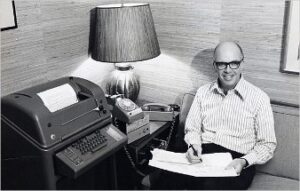
Dr. James Marsters, a deaf orthodontist, played a pivotal role in creating the first text telephones (TTY), revolutionizing communication for the deaf community. Born on April 5, 1924, in Norwich, New York, Marsters became deaf after contracting scarlet fever as an infant and was taught to lip-read and speak from an early age. Marsters faced significant challenges in his pursuit of higher education and professional advancement. After years of rejections, New York University College of Dentistry admitted him on a provisional basis with the understanding they would not offer any special accommodation. He graduated in 1952, becoming one of the first deaf dentists in the country. He completed a fellowship in orthodontics at the University of Southern California in 1954 and started a private practice in Pasadena, California.
In the early 1960s, Marsters, along with physicist Robert Weitbrecht and electrical engineer Andrew Saks, began experimenting with converting teletype machines into devices that could relay typed conversations through telephone lines. This invention, known as the TTY, used an acoustic coupler, now known as a modem, to transmit machines’ electrical signals over phone lines as tones. Their collaboration resulted in the first long-distance TTY call in 1964, marking a significant milestone for the deaf community.
The impact of the TTY was profound. It provided deaf individuals with independent access to telephone communication, enabling them to connect with others without the need for intermediaries. Marsters and his colleagues founded Applied Communications Corporation to refurbish and distribute TTYs, advocating for the adoption of this technology and the establishment of relay services. These efforts laid the groundwork for legislation in the Americans with Disabilities Act of 1990, which mandated telecommunications relay services for the deaf and hard of hearing.
For nearly four decades, TTY was the primary means of long-distance communication for the deaf and hard of hearing. While the rise of the Internet has rendered TTY largely obsolete in favor of instant messaging and email, it remains in use for emergency services, preserving its transformative impact.
Dr. Marsters’ contributions extended beyond the TTY. He was a licensed aviator, a magician, and an active member of both deaf and hearing communities.
Marsters passed away on July 28, 2009, at the age of 85, leaving behind a legacy of innovation and advocacy that greatly improved the lives of countless individuals. His work on the TTY not only provided a critical communication tool but also inspired future advancements in telecommunications.
Author: Seung Sun (“Elvis”) Kim
